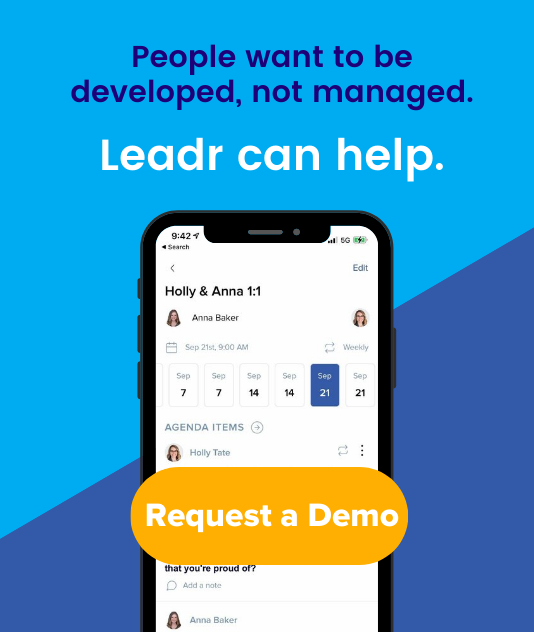How to Develop Your People: Advice from HR Expert Michael Erisman
How to Develop Your People: Advice from HR Expert Michael Erisman
Learn from the HR superstar who has developed teams for over 25 years at GE, Microsoft, Pushpay, and Leadr.
This article comes from a conversation between Leadr Board Member Michael Erisman and Chris Heaslip, Co-Founder and Executive Chairman at Leadr. Watch the video of their conversation above.
This is part of the Principles in Practice blog series from Leadr, based on the Principles in Practice interview series on Leadr’s Youtube page. This series highlights significant insights from interviews with organizational leaders. Chris Heaslip, Co-Founder and Executive Chairman at Leadr, conducts each interview. Chris is also a dedicated entrepreneur, who has started over 15 startups, including the highly successful Pushpay.
Some People See HR Simply as a Compliance Function. How Do You See HR?
Compliance functions are important, but HR is, of course, much more than that. Your ability to succeed is going to come down to your people, and not only which people, but how those people work together to achieve something greater than themselves. There are “people implications” at every decision you make. The pandemic has demonstrated the importance of having a high-performing HR team that understands their role past compliance functions. The organizations that were ahead of that curve when the pandemic hit barely missed a beat. Organizations that were less flexible had a more difficult time making that transition. Michael believes that this is fundamentally what HR is supposed to do. HR should constantly be asking the question, “What are the people implications of what's happening in the world and what do we want to accomplish [at our organization]?” That starts with planning ahead.
According to Michael, considering people implications means asking questions like, “Do we have the right tools to enable people to lead in a different way?” or “Are the people here today going to be the people that we need tomorrow?” The decisions that are made which arise from asking questions like these are what HR is all about.
As Someone Who Has Worked for Multinational Companies, What HR Principles Transcend Company Size?
Michael tends to look at HR like a gap analysis. He asks, “What is the outcome we're trying to get? Where are we now? What's the gap in between and what levers can we pull to get there?” One of the things smaller organizations should realize is that it is just as important to reach out to people who can help guide you in your growth curve as it is to reach out to people who help with creating or funding the project. Michael has found that achieving success is less about what or who you put in place and is much more about when. Even the smallest organizations can take advantage of the advice of someone who is thinking about the “when.”
Michael also emphasizes the importance of agility. There is an advantage to partnering with people who have seen something at scale and can help you recognize when the development curve is coming. It is less about an HR person or a role and more, “Are we all thinking about these HR concepts every day?” This is how a small organization can succeed at an HR level without investing in a full HR team.
What Are Some HR Mistakes You Have Seen Smaller Organizations Make?
“You are always hiring for what you needed yesterday.” Michael explains that every organization, big or small, runs into this problem. The person who can pull your organization forward is usually someone who requires more than is budgeted. Big organizations have the flexibility to get those kinds of hires, whereas small organizations need to be much more strategic about their limited resources. The biggest mistake Michael sees made by small organizations is a lack of strategic planning to get the right hires for the right positions.
Michael has noticed the tendency of organizations to put their people into boxes, as opposed to coaching their people through complex problems to help them develop. “I think success or failure is going to depend entirely on an organization's ability to do this.” Talent, of course, plays a role in the success an employee is going to have. But, more important than talent, organizations need to put people in a system that enables them to be successful. “If you're listening to me today, every single person in your organization is in development. They are in transition. They are either coming into something or they're going to something or they're learning, or they are growing.” Our people are always on their way to something. More than ever before, that “something” is the next opportunity past your organization. “We lease people,” says Michael. If we recognize that, then the question becomes, “How do we help them develop and grow? And then how does that correlate back to what we need as an organization?” The leaders that tap into that have an infinite amount of potential within their team.
If you trained your people to have the capability to do what you do today, what would you get to spend your time on? What are the untapped opportunities of potential that you simply don't have time to get to today? That is what we should be trying to tap into. It is a win-win. Your people are developing and growing, while you have the capacity to innovate and do new things.
How Was Your HR Approach Shaped by Your First HR Role at General Electric?
Jack Welch, the former CEO of GE, had a unique perspective about HR. He had this mentality that success was all about people. He used the analogy of a baseball team, asking, “If you owned the Boston Red Sox, would you spend more time with your accountant or with your director of player personnel?” The answer is that you would probably spend more time with your people, your players, your team. The takeaway Michael learned was that an organization’s leader should spend time with his or her HR team so that he or she can best invest in and partner with the people in the organization.
Michael explains that at GE he learned to look at his people and recognize who they are so that he could help them grow. He also learned how to think about managing someone who may be underperforming. Michael has found that it is a disservice to your organization and to that person if you choose not to directly manage them. “If you treat everybody the same, who amongst those people are going to be the most disillusioned? It's going to be your best performers…you're not going to lose the people that are just kind of showing up and getting the minimum done. You're going to lose your best people.” Do not be afraid to differentiate your performers and your non-performers. It may not be fun in the short term, but it will make a huge difference for your organizational culture in the long run.
How Have You Helped High-Performing Individual Contributors Become Successful Managers?
“If I was building a basketball team, and I could pick any player, I'd probably pick Michael Jordan, right? Or Wilt Chamberlain. But if I was picking a coach, I wouldn't pick those two people at all, right?” Michael uses this analogy to describe why it is rarely the top individual contributor who makes for the most successful manager. Oftentimes, organizations take their top performers and make them manage the team. Instead of keeping this person in a role where he or she contributes in an important way, we ask him or her to be a leader of people. High-performing contributors are rarely good leaders of people. A candidate for frontline manager, is a great fit when the person is someone who represents the culture of the organization well. Michael says that culture fit should be a priority when choosing a manager.
How Do You Build Culture Remotely?
“Culture is some amorphous thing in between what you aspire to be and what you actually are… it often comes down to what you tolerate, what you recognize, and what you reward.” For Michael, building a culture remotely is no different than building it in an office. Set clear goals. Define what is accepted. Recognize and reward that which meets the goals. Praise publicly and coach privately, and never stop recognizing your people. Don't stop doing team events, don't stop giving feedback, and don't stop coaching. The only real difference in remote culture is that it takes more discipline and more time.
What Are Consistent Characteristics You Have Observed in Great Leaders?
The number one characteristic is vision. A leader simply has to be able to look ahead and see what needs to happen. Vision, however, has to be partnered with a “fundamental belief in the value of people,” according to Michael. A leader does not treat people as objects or means to accomplish a task. A leader treats people as individuals. Michael says, “If you can tap into the hearts and minds of people, you can change the world.”
Are you ready to starting leading and developing your staff at every level of your organization? Here at Leadr, we help your team love Mondays just as much as they love Fridays by helping every manager become a coach and giving every employee a voice.
Share this
You May Also Like
These Related Stories

Your Team’s Not Just There to Work. They’re There to Grow.

Three Steps to More Effective 1:1 Meetings




No Comments Yet
Let us know what you think